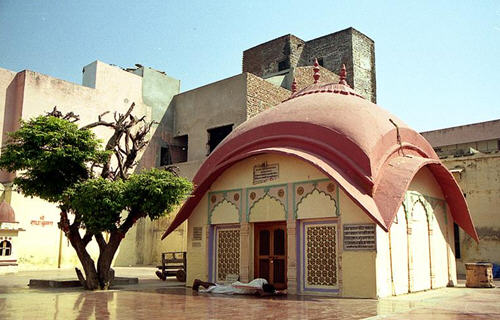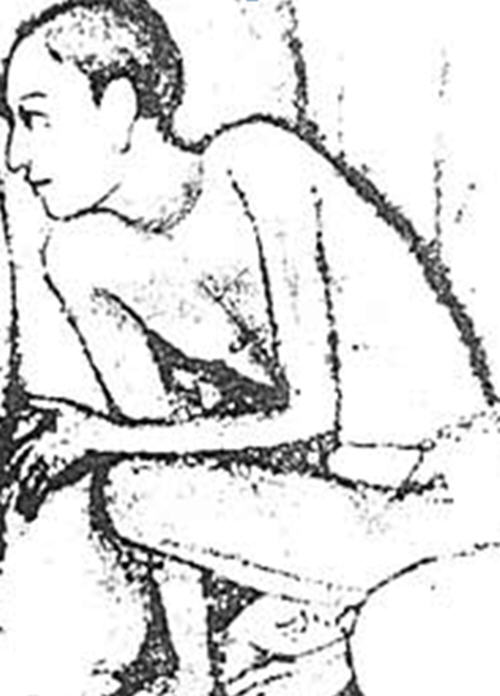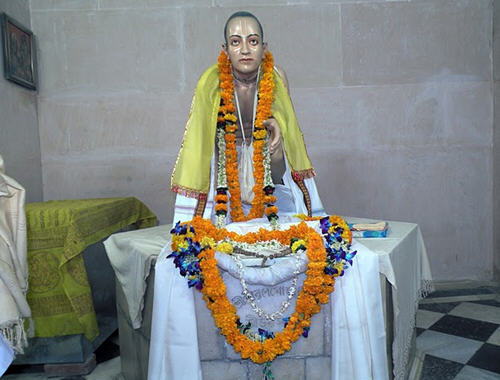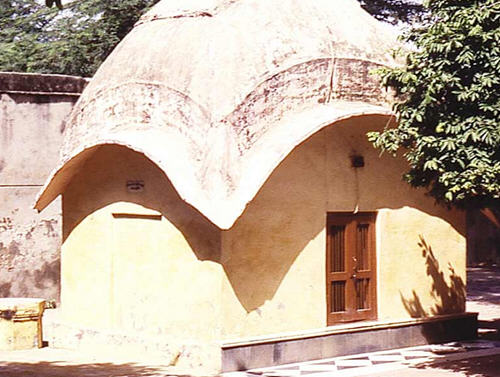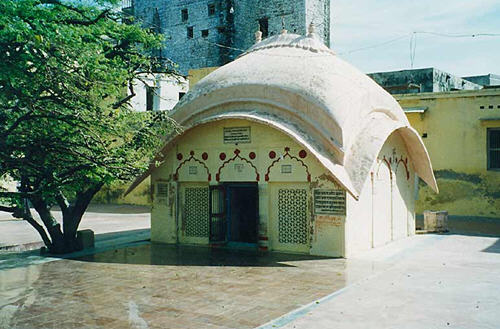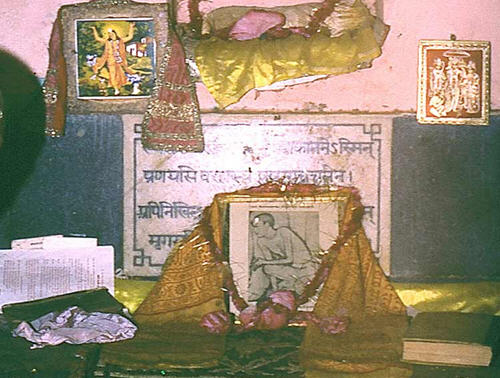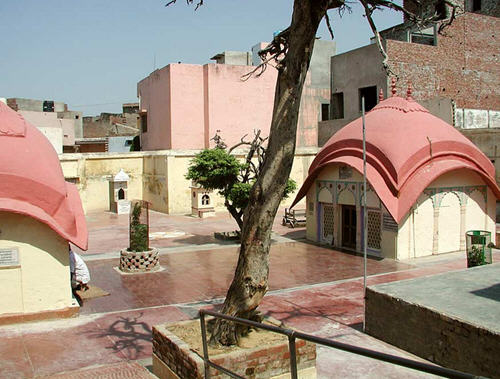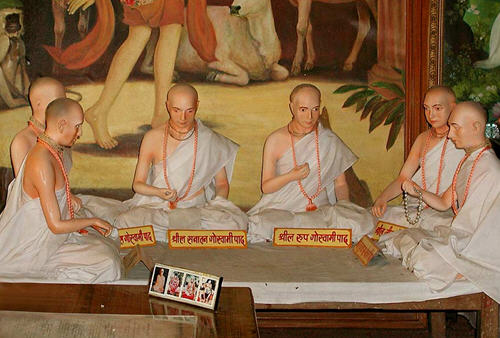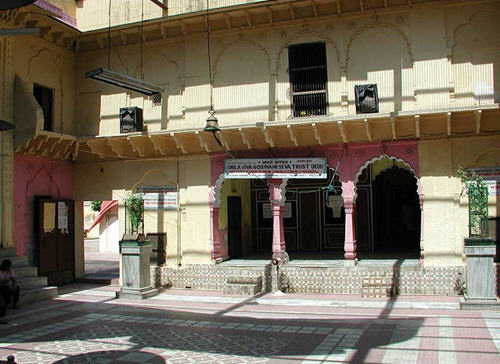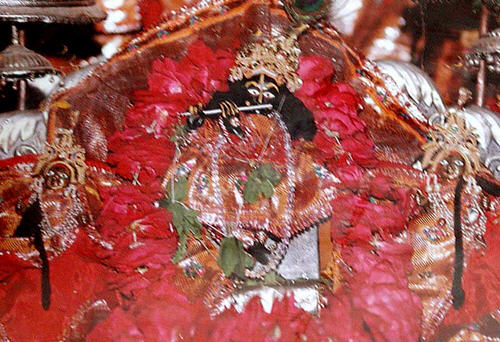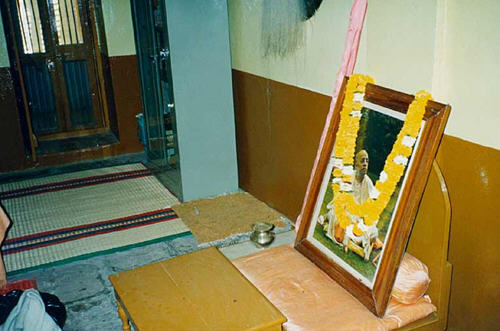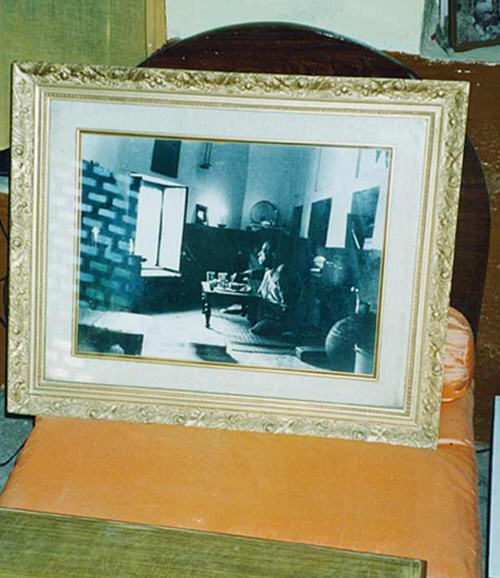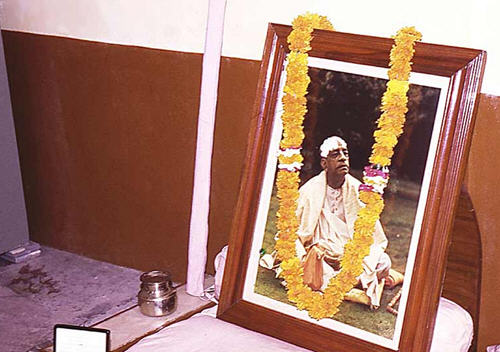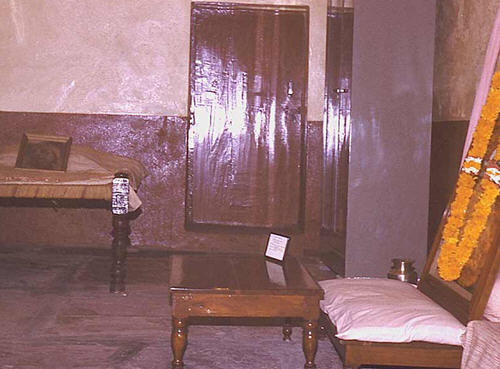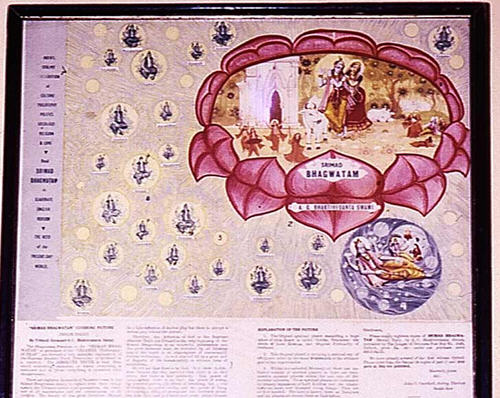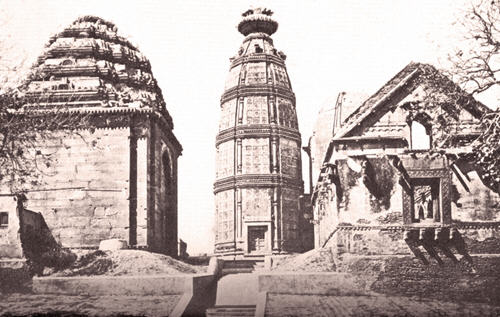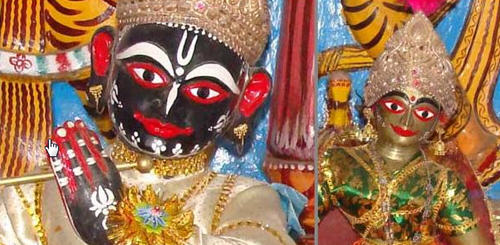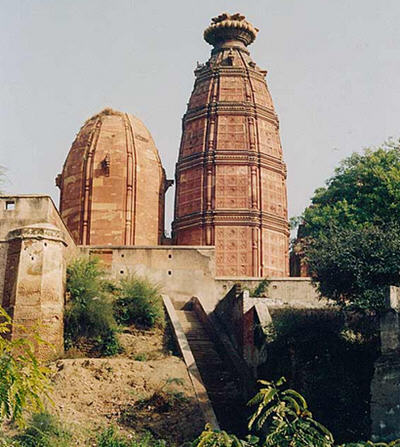Sri Sri Radha Syamasundara Temple
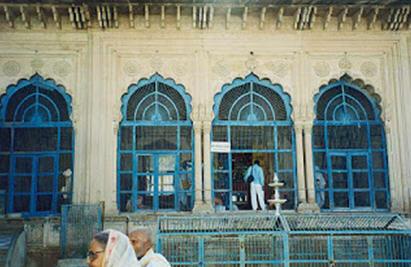
Sri Sri Radha Shyamasundar:
This is one of the most important temples for Gaudiya Vaishnavas. Established by Sri Syamananda Pandit the deity itself was gifted to him by Srimati Radharani, the consort of Lord Krishna, who had manifested it from her heart. Sri Sri Radha Shyamasundar;
Among the seven main temples of Gaudiya Vaishnava sect in Sri Vrindavan Dham, the temple of Sri Sri Radha Shyamsundar has carved a special place for itself in the hearts of all the Vaishnavas because it houses the most beautiful and unique Deity of Sri Shyamsundar, that manifested from Srimati Radharani’s heart.All the prominent acharyas of Gaudiya Vaishnava cult used to visit this divine temple to have darshan of His Lordship, Sri Shyamsundar.

Sri Shyamasundar:
Srila Raghunath Dasa Goswami and Srila Krishna Dasa Kaviraja Goswami, who would otherwise never leave Sri Radha Kunda, also started visiting Vrindavan for the darshan of Sri Shyamsundar, despite their old age and physical problems. Srila Baladeva Vidya Bhushana spent most of his time in Vrindavan in the service of the Deity.

Sri Sri Radha Shyamasundar Temple:
Deity History
Srila Shyamananda Prabhu’s childhood name was Dukhi. From his very childhood, Dukhi’s heart was imbibed with devotion to Lord Krishna. By listening to the pastimes of Caitanya Mahaprabhu, Nityananda Prabhu and Their associates, he used to become ecstatic, weep and moisten his clothes by the tears gliding down his cheeks. Due to deep love for Krishna he would usually show the symptoms of ecstasy such as crying, laughing and dancing. In the month of Phalgun in 1553 A.D. at the age of 18, he left home for Ambika near Navadvip Dham without informing anyone, to take shelter under the lotus feet of his would be spiritual master. On the way he braved many rivers, rivulets, hillocks and dense forests full of beasts. On Phalguni Purnima of 1554 A.D., he took initiation from Sri Hridaya Caitanya Adhikari Thakur, a disciple of Sri Gauri Dasa Pandit (Subal Sakha of Vraja). At initiation he received the name Dukhi Krishna Dasa.
On the instructions of his spiritual master he set out on pilgrimage to all the holy places in India including Sri Vrindavan Dham. After the pilgrimage, he returned to his village in 1562 A.D. and married Gaurangi Dasi as per his parent’s wish. But due to the utmost attraction for Vraja he could not stay in his village for long and returned to Sri Vrindavan Dham in the year 1566 A.D. He experienced that the land of Vrindavan was adorned with desire trees and was made of touchstones. Everywhere the fragrant aroma of the divine love of Sri Sri Radha Shyamsundar pervaded the air. Therefore he glorified Sri Vrindavan Dham as the topmost abode in the universe.
He reached Nandagram and after seeing the palace of Nanda Maharaja where Shyamsundar performed many pastimes, he wept bitterly and started paying obeisances to this transcendental village again and again. Dukhi Krishna Dasa then visited the place of King Vrishabhanu known as Barsana. After visiting the pleasure dome of Srimati Radharani, he experienced transcendental joy. Soon after he sojourned Govardhana Hill and after seeing the sacred mountain, memories of Krishna’s pastimes started sprouting in his heart. He started dancing and glorifying Govardhana Hill with choked voice. While circumambulating Govardhana Hill, he had darshan of Sri Radha Kunda and Sri Shyama Kunda. They were full of sweet water and surrounded by beautiful lotus flowers and groves. He felt excited after touching the scintillating water and offered his due respect to the sacred ponds.
Sri Dukhi Krishna Dasa then went to Yavat and returned to Vrindavan. Having darshan of Sri Radha Govinda, Sri Radha Gopinath and Sri Radha Madana-mohan, he lost his senses due to ecstasy and thereupon whenever he saw Krishna, he saw Radharani also because one cannot have a glimpse of the moon without it’s light.
During his meeting with Srila Raghunath Dasa Goswami and Srila Krishna Dasa Kaviraj Goswami at Radha Kunda, Srila Raghunath Dasa Goswami sent him to meet Srila Jiva Goswami. As soon as Dukhi Krishna Dasa met Jiva Goswami and paid his obeisances at his lotus feet, the latter felt a wave of ecstasy passing through him and it occurred to him that his wait for the arrival of a desired personality had come to an end. Sri Srinivasa Acharya (embodiment of Caitanya’s love), Sri Narottama Dasa Thakura (embodiment of Nityananda’s love) were already with him. Now the embodiment of Advaita Acharya’s love also reached there. Srila Jiva Goswami got busy to draw plans to spread Krishna Conscious literature to other parts of the world with the help of this confluence of three Bhakti streams.
Due to his extraordinary personality, his spirituality, humility, virtuousness and devotion, people loved Krishna Dasa very much. For Srinivasa Acharya and Narottama Dasa Thakura he was the wealth of their heart and for Jiva Goswami, he was the apple of his eye. Jiva Goswami advised Krishna Dasa to study books written by the six goswamis, listen to Krishna Katha and chant Hare Krishna but Krishna Dasa requested for some more transcendental service to the Lord. Srila Jiva Goswami also granted him the rare opportunity of cleaning the sacred groves of Seva-kunj. In this way he rendered service for twelve years and progressed in devotional service to Lord Krishna.
One day, while sitting in his bhajan-kutir, he was deeply immersed in remembering the sweet and nectarean pastimes of Radha and Krishna. He felt that Shyamsundar was dancing and singing with the beautiful damsels of Vraja in the grove. Srimati Radharani and the gopis had formed a circle around Shyamsundar by holding each other’s hand and it appeared like the moon encircled by the stars. Some gopis were dancing and others were singing melodious songs. At the same time Srimati Radharani started dancing attractively to give more joy and pleasure to Sri Shyamsundar and it also made Him drown in this ocean of ecstasy. During the dance, a golden anklet named Manjughosha which was studded with precious gems, slipped from the left foot of Srimati Radharani and fell in the dancing arena unnoticed. When the dance was over the divine couple went to sleep on a well decorated bed in the grove. By looking at the united couple all the gopis also became serene in their mind. In the morning the couple felt ashamed when they were awakened by all the gopis and everyone proceeded towards their respective houses.
Even Dukhi Krishna Dasa woke up and as usual left for cleaning the groves. On reaching the place of the pastime, he noticed more signs of merry making as compared to previous days. The creepers laid scattered here and there. Despite that all the trees and creepers were full of fragrance emitting flowers. On the inner side of the grove foot-prints of Radha and Krishna and the gopis could be seen. Charged with ecstasy and love of Godhead Dukhi Krishna Dasa started rolling on the sacred ground. Somehow or the other he controlled himself and started cleaning the groves. Suddenly he saw a glittering object under a pomegranate tree illuminating every nook and corner of the grove. He ran towards that spot. He became wonderstruck on finding a transcendental anklet studded with precious stones called Indraneel mani.
Immediately there was a prophecy from the sky to guard the anklet. He lifted the anklet and touched it to his forehead. A wave of high devotion passed through his head. Tears started rolling down his cheeks and symptoms of ecstasy appeared in his body and he started dancing uttering the names of Srimati Radharani. With great effort he hid the anklet under his garment and continued his work of cleaning and beautifying the dancing arena and groves of Seva-kunj.
During this time Srimati Radharani came to that place in disguise with Her associates in search of the anklet. She hid behind a creeper and asked Lalita sakhi to look for the anklet. Sri Lalita sakhi, in the disguise of a poor old Brahmin lady, approached Krishna Dasa and told him that the previous night her newly married daughter-in-law had come to that place to pluck flowers, but having seen a lion (Krishna) standing next to Her, She left the place in fear. At that time, an anklet from Her left foot had slipped and fell on the ground unnoticed in Nidhivan. She inquired from him whether he had found it. Hearing these words from Sri Lalita sakhi, Krishna Dasa felt satisfied but showered a list of questions out of anxiety such as “Who was she? And where did she live?” “Kindly give her introduction to my complete satisfaction,” he requested.
Lalita sakhi said, “She is a ‘Kanya-kubja Brahmin lady’ and belongs to a village near Yavat of Mathura and Her name is Radha Dasi.” She further said, “Since you clean the groves everyday, I have come to enquire about the anklet.”
Krishna Dasa with great humility answered, “Your guess is true. I did find a wonderful anklet studded with Indraneel mani. As soon as I touched the anklet, I was charged with divinity, felt happiness and was also over-whelmed with love for Srimati Radharani.” In a doubt he further added, “This anklet surely does not belong to an ordinary lady. There is some mystery behind this. Wise people say that wonderful things are possessed only by deserving people and not by ordinary persons.”
“Since your daughter-in-law is an inhabitant of this material world, the transcendental anklet cannot belong to her,” he said. In a view of confirming the situation he further told Lalita sakhi, “You belong to this material world, therefore my mind does not feel satisfied to part away with the anklet in your favor as you are just like the material entity and the transcendental ornament cannot belong to you.”
Pointing at her ordinary dress he said, “Your ordinary garments speak of your poverty. An anklet embedded with Indraneel mani cannot belong to the daughter-in-law of a poverty-stricken lady under any circumstances.” He thought for a while and agreed on one condition, “However if your daughter-in-law comes before me to show the similar anklet on Her right foot, I will return the anklet in the presence of the villagers.”
Srimati Radharani, the daughter of Sri Vrishabhanu who with Her companions was listening to the conversation of Sri Lalita sakhi and Sri Krishna Dasa from behind a creeper, felt that Lalita sakhi was no match to Sri Krishna Dasa as far as cleverness was concerned. Srimati Radharani came out and said, “O saintly person! You said that this transcendental anklet does not deserve to be given to any person of this material world, but don’t you know that all the objects of Vrindavan are transcendental? Does any ordinary person of this material world have the right to enter Vrindavan?”
Cleverly Sri Krishna Dasa replied, “Your words that all the objects of Sri Vrindavan Dham are transcendental are absolutely true but those objects are not visible to the materially naked eyes. This land as known by the shastras and wise people looks earthly although it has touchstones and is filled only with desire trees.”
Listening to the very clever answer of Sri Krishna Dasa, Lalita sakhi laughed mildly but keeping in mind the execution of her task, she said to Krishna Dasa, “Your observation is perfectly right. The anklet found by you is absolutely transcendental and it’s owner is also extremely transcendental in Her beauty, Her nature, Her dress, Her characteristics and above all in Her virtues.”
Krishna Dasa felt little perplexed and pointing towards the old lady who was using mysterious phrases, he said, “I am unable to understand you as I lack wisdom. Moreover how can I know what you want me to do? Kindly explain to me in plain words what can I do for you?” Then Lalita sakhi disclosed their identity and with confidence said, “This lady standing to my right is the owner of this transcendental anklet. She is Srimati Radharani, the daughter of King Vrishabhanu. She is the resident of Yavat and the sweet heart of the King of Gokula.”
This introduction of Srimati Radharani was enough for Krishna Dasa to be surprised and his body was charged with symptoms of ecstasy. He became dumbfounded and entered into a trance for some time. But after a while he regained his senses and with hesitation said: “I am afflicted with pain and fail to understand how the anklet of Srimati Radharani fell on the ground in the dancing arena. I want to know the complete event as my heart is feeling uneasy and restless.”
Sri Lalita sakhi said, “You are the right person to know about this and thus I will reveal the whole story as it is to you.” Sri Lalita sakhi then narrated as follows: When the night approached, at that very moment the moon, the Lord of the stars, appeared in the sky displaying its most beautiful features. When the full moon rose in the east, it tinged everything with a reddish color. With the rising of the moon, the whole sky appeared smeared by red kumkuma. The forests were filled with fragrant flowers. The atmosphere was cooling and festive.
Sri Shyamsundar was immersed in performing rasa lila. During the dance, a golden anklet named Manjugosha slipped from Radharani’s left foot and fell in the dancing arena. A female parrot and a female monkey Samyagya uttered that the night was about to end and the sun was soon to rise. They warned that Jatila may soon come to know about the meeting between Radharani and Shyamsundar. Hearing the name Jatila from their mouths, Radha and Krishna decided to return to Their homes. Since Srimati Radharani left the place in a hurry, she did not notice the loss of Her anklet. She found the anklet missing only on Her arrival at Her home and was restless. The anklet had been gifted to Her by Her mother-in–law out of deep affection, the previous night. She expressed that either it had fallen somewhere on the way home or in the grove at the dancing arena. She advised the gopis to consult each other and decide the future course of action accordingly.
At this, one of Her sakhis guessed that the anklet could have slipped and fallen on Her way back home. The other sakhi expressed the view that the anklet could have fallen somewhere in the grove. While this discussion was going on, wise Vrinda-devi appeared and consoled Srimati Radharani telling her that she had heard from the parrot named Vichakshan that a very fortunate person had found the anklet in the dancing arena. She advised that they go to the dancing arena to bring back the anklet from that person. She further advised that they would go with Radharani for that purpose. On hearing these words of Vrinda, all the sakhis told Radharani to go to the grove to get the anklet.
Unveiling the purpose of their visit Lalita sakhi said, “Please return the anklet so that we can go back soon before the short-tempered mother-in-law of Srimati Radharani, Jatila, wakes up. You can have anything from us in exchange for this anklet.” Hearing all this Krishna Dasa felt delighted and fell on the feet of Lalita sakhi. He took out the anklet from his upper garment, touched it to his head and gave it to Lalita sakhi. With folded hands he expressed his desire as follows:
“Can I have darshan of your divine form?”
Affectionately Lalita sakhi said, “It is difficult, rather impossible, for you to have my darshan with the help of these material eyes.”
Krishna Dasa replied, “I will be definitely able to have your darshan if you are kind enough to shower your mercy on me. Again I request you to kindly fulfill this desire of mine.”
Lalita sakhi then empowered him with transcendental vision and showed to him her divine form. Having her darshan, Krishna Dasa trembled with ecstatic waves of love and fell unconscious on the ground, Sri Lalita sakhi touched him and he recovered. Regaining his senses he requested her, “Please give me an opportunity to serve Sri Radha Shyamsundar in Goloka Vrindavana.” But Lalita sakhi denied and said, “This can only be possible after you leave the material world. Kindly ask for something else.” He then requested to have darshan of Srimati Radharani’s lotus feet. At this Lalita sakhi became worried but on hearing the humble request of Krishna Dasa, Srimati Radharani told Lalita sakhi as follows:
“Give him My mantra and make him take bath in Radha Kunda. He will then take the form of a ‘Manjari’ and will be able to have My darshan. Please do not delay as Krishna Dasa is extremely dear to Me.”
As per the directions of Srimati Radharani, as soon as Sri Krishna Dasa took bath in Radha Kunda after chanting the mantra, he attained the transcendental form of a ‘manjari’. Whoever saw him in that form, was perplexed. His body resembled molten gold, his waist was like that of a lion’s and his beautiful eyebrows were shaped like a bow to shake even Cupid. He wore fine silken clothes. Placing the anklet on his head, he entered the temple of Srimati Radharani. Presenting him at the lotus feet of Srimati Radharani, Sri Lalita sakhi requested, “Please place Your lotus feet on his head to consider him Your own follower.”
Srimati Radharani gravely said, “In your previous birth you were Krishna-priya and was my companion. Because of this I will show My special favor on you by placing you among My own followers.”
“Give the sign of My anklet on his forehead,” Srimati Radharani directed Lalita sakhi.
As soon as Lalita sakhi touched his forehead with the anklet, his Harimandir tilak was converted into transcendental tilak of the shape of Srimati Radharani’s foot. Srimati Radharani took kumkum, sandal and camphor adorning Her body, mixed them with honey and rubbed them on a stone known as chandrakant. With the help of the front part of the anklet, She drew a bright round mark in between the Noopur Tilak on the forehead of Krishna Dasa.
Lalita sakhi on seeing the round mark said to Radharani, “This new tilak adorning the forehead of Krishna Dasa will be known as ‘Shyam Mohan Tilak’. This sakhi (Krishna Dasa) upon whom Srimati Radharani has showered Her blessings has delighted Her very much. In view of this he will be known as Shyamananda from now onwards.”
Vishakha sakhi seeing his new form addressed him as ‘Kanak Manjari’.
Srimati Radharani said to Kanak Manjari, “You are very dear to Me like Lalita and Vishakha because you have pleased Lord Krishna and has given pleasure to My own eyes.”
Sri Lalita and Vishakha sakhi while deeply appreciating these words spoken by Srimati Radharani, praised him and said, “Kanak Manjari has become glorious by Your grace. Having found Your anklet under a pomegranate tree in the grove, Kanak Manjari has attained a special status among Your companions. Saci, Savitri and other godly women will always long to sit near her feet because You have recognized her among Your distinguished companions.”
Addressing Krishna Dasa Srimati Radharani said, “With all My associates you have given Me great pleasure. Now you go back to the material world to complete the assigned work and with My grace the remembrance of this event will go on giving you unlimited pleasure.” Hearing these words Kanak Manjari started weeping in distress and with tears in his eyes said in the chocked voice to Srimati Radharani, “You had been very kind to bring me here to serve Your lotus feet. Please do not send me to the material world again. Please let me serve Your lotus feet only.”
Hearing the most painful request of Kanak Manjari, Srimati Radharani felt deeply afflicted and fondling her head, She expressed, “You are My eternal companion yet you have been sent to the material world for a specific purpose. After your assignment of liberating the conditioned souls is completed, you will be called back to serve Me. Since your separation from Me is causing distress and you are experiencing unbearable pangs of separation, I am giving you a Deity which is very dear to Me. By serving Him with extreme love and devotion, you will be able to forget My separation and the desires of all the human beings will also be fulfilled by serving and seeing this Deity.”
Saying this Srimati Radharani manifested the most beautiful and unique Deity of Sri Shyamsundar from Her lotus heart and gave to Kanak Manjari through Lalita sakhi. While delivering the Deity to Shyamananda Prabhu, She said, “O Shyamananda! The living entities affected by Kali-yuga are short lived and bereft of the Lord’s devotion. I am giving this Deity as a simple means of liberation of those living entities.”
Srimati Radharani further instructed Shyamananda prabhu, “O Shyamananda! Beloved of Sri Krishna, I am giving you this Deity for the welfare of the world. You should yourself engage in His service and worship Him till your stay in the material world for the well being and liberation of the conditioned souls. After that you will come back to us for our eternal service.”
Sri Lalita sakhi advised him, “O Shyamananda!! Do not narrate this pastime to anyone except Srila Jiva Goswami. If you dare to make it public, you will have to embrace death and you will be deprived of the service to Srimati Radharani.”
Sri Lalita sakhi assured him, “Whenever you are in trouble, you will have my darshan on chanting the divine Radha Mantra given to you by me.” Srimati Radharani then disappeared with Lalita and Vishakha sakhis after bestowing Her grace upon him.
After that Sri Krishna Dasa regained his past form and went out of the grove. His iron scraper had been converted into a golden scraper after having the touch of the anklet. With tears in his eyes and overwhelmed with ecstasy, Krishna Dasa presented himself before Srila Jiva Goswami in his hut bearing the Noopur Tilak on his forehead, Shyamananda written on his chest, the golden scraper under his armpit and the unique Deity on his head. Seeing Krishna Dasa Jiva Goswami was surprised. He noticed that the fair complexioned Krishna Dasa was now having a body with golden hue. His Harimandir tilak was changed to a new Noopur Tilak of the shape of Srimati Radharani’s lotus foot with a radiant round mark within it. The iron scraper had been converted into a golden one. Above these he was in possession of a wonderful, transcendental and marvelous Deity of Krishna.
He asked, “O Krishna Dasa! Where had you been all this time? How has your complexion changed? You should tell everything to me sincerely. I think you have been definitely blessed either by Krishna or Srimati Radharani.” As a highly realized soul, Srila Jiva Goswami observed that something mysterious had occurred.
Krishna Dasa took Jiva Goswami in a solitary place and narrated the whole story word by word in a chocked voice, with the clear warning of Lalita sakhi desiring him not to disclose anything to anyone except Jiva Goswami. Hearing about the transcendental favor bestowed upon Krishna Dasa by Srimati Radharani, he became mad with love of Krishna, felt delighted and started dancing. He started shedding tears out of deep love and embracing Krishna Dasa said, “You are the fortunate to be blessed one in this world as Srimati Radharani has bestowed Her blessings to you. Just by touching you I am also feeling blessed by Her. In Vaishnava sect you will be known as Shyamananda, one who gave pleasure to Srimati Radharani and your tilak will earn fame as Shyamanandee tilak. The unique and transcendental Deity gifted to you by Srimati Radharani will be famous as Shyamsundar and He will continue to give darshan and liberate the conditioned souls. O Kanak Manjari! I once again say that you are the only blessed one in this whole world. ”
This Deity of Shyamsundar continues to give darshan even today in Sri Vrindavan Dham.

Sri Sri Radha Shyamasundar:
The temple is situated at Seva-kunj near Loi Bazaar in Sri Vrindavan Dham on the same road as the Radha Damodar temple.
Postal Address:
Sri Sri Radha Shyamsundar Mandir
Seva Kunj
Sri Vrindavan Dham – 281121
Mathura
Uttar Pradesh
India
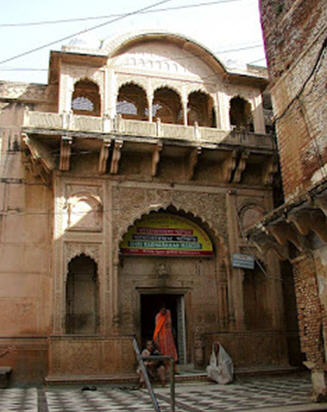

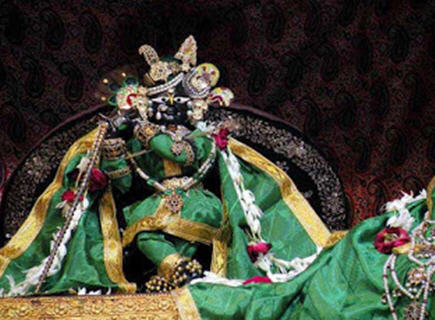
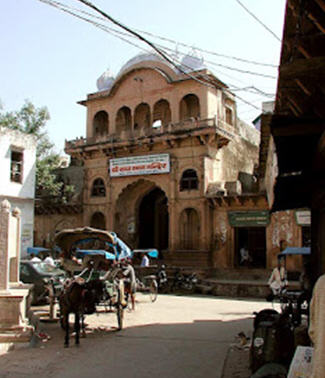

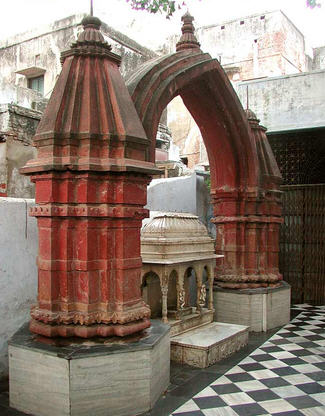
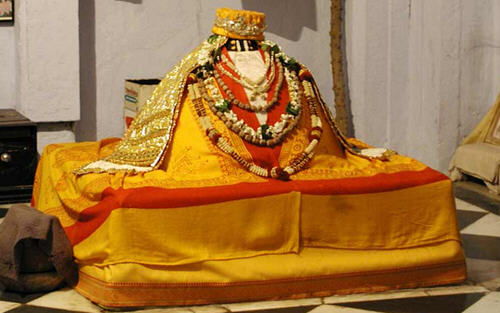
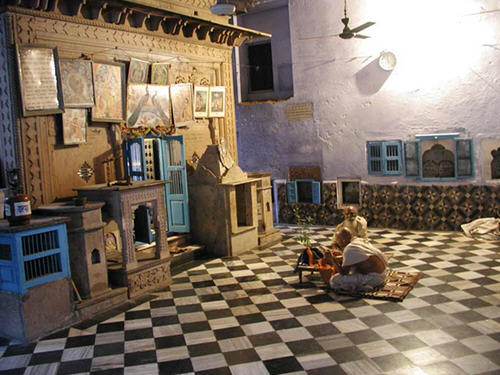




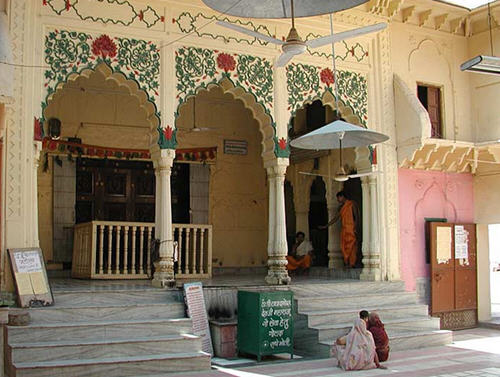
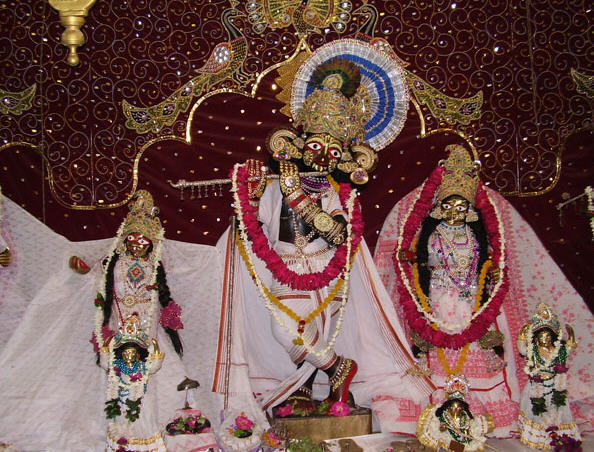
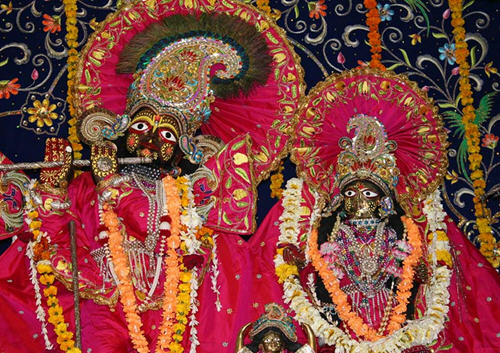

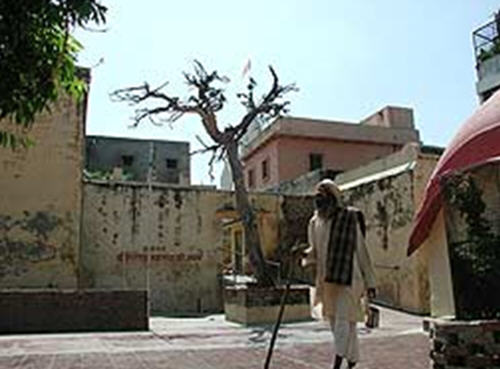
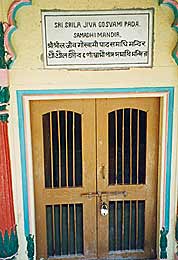
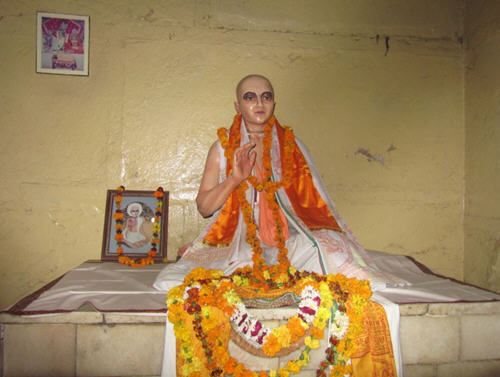 ..
..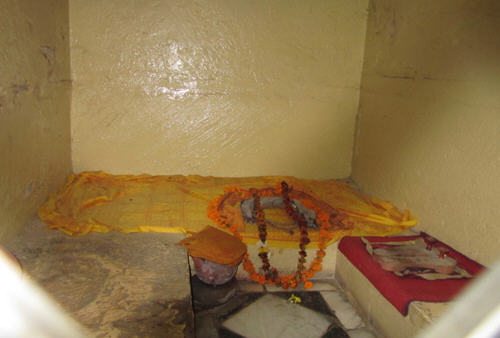
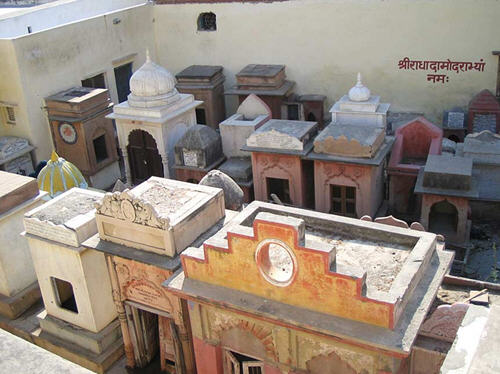

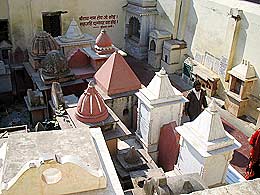 ..
..